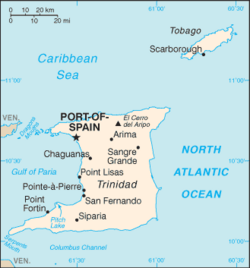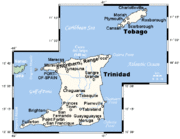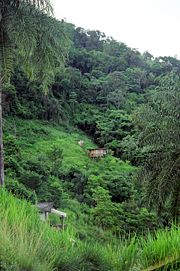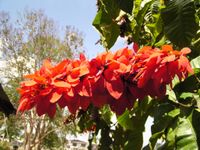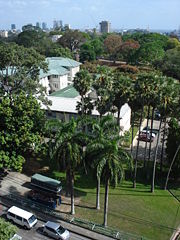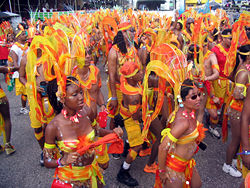Trinidad and Tobago
2008/9 Schools Wikipedia Selection. Related subjects: Americas; Countries
| Republic of Trinidad and Tobago | ||||||
|---|---|---|---|---|---|---|
|
||||||
| Motto: "Together we aspire, together we achieve" | ||||||
| Anthem: Forged from the Love of Liberty |
||||||
|
|
||||||
| Capital | Port of Spain |
|||||
| Largest city | San Fernando | |||||
| Official languages | English (Official), Spanish (Special Status) | |||||
| Ethnic groups | Indians, Africans, Venezuelans, Spanish, French, Portuguese, Chinese, British, Lebanese, Syrians, Caribs. | |||||
| Demonym | Trinidadian, Tobagonian | |||||
| Government | Parliamentary republic | |||||
| - | President | George Maxwell Richards | ||||
| - | Prime Minister | Patrick Manning | ||||
| Independence | ||||||
| - | from the United Kingdom | 31 August 1962 | ||||
| Area | ||||||
| - | Total | 5,128 km² ( 172nd) 1,979 sq mi |
||||
| - | Water (%) | negligible | ||||
| Population | ||||||
| - | July 2005 estimate | 1,305,000 ( 152nd) | ||||
| - | Density | 207.8/km² ( 47th) 538.6/sq mi |
||||
| GDP ( PPP) | 2005 estimate | |||||
| - | Total | $18.352 billion ( 113th) | ||||
| - | Per capita | $19,700 ( 46th) | ||||
| HDI (2007) | ▲ 0.814 (high) ( 59th) | |||||
| Currency | Trinidad and Tobago dollar ( TTD) |
|||||
| Time zone | ( UTC-4) | |||||
| - | Summer ( DST) | ( UTCn/a) | ||||
| Internet TLD | .tt | |||||
| Calling code | +1-868 | |||||
The Republic of Trinidad and Tobago (pronounced /ˈtrɪnɪdæd ən təˈbeɪgoʊ/) is an archipelagic state in the southern Caribbean, lying northeast of the South American nation of Venezuela and south of Grenada in the Lesser Antilles. It also shares maritime boundaries with Barbados to the northeast and Guyana to the southeast. The country covers an area of 5,128 square kilometers (1,979 sq mi) and consists of two main islands, Trinidad and Tobago, and 21 smaller islands. Trinidad is the larger and more populous of the main islands; Tobago is much smaller, comprising about 6% of the total area and 4% of the population. The nation lies outside the hurricane belt.
Officially Trinidadians or Tobagonians, the people from Trinidad and Tobago are often informally referred to as Trinbagonians or Trinis (for Trinidadians). Unlike most of the English-speaking Caribbean, Trinidad and Tobago is a primarily industrialised country whose economy is based on petroleum and petrochemicals. Trinidad and Tobago is famous for its pre- Lenten Carnival and as the birthplace of steelpan, calypso, soca, and limbo.
History
Tobago’s cigar-like shape gave it its Spanish name (cabaco, tavaco, tobacco) and possibly its Amerindian names of Aloubaéra (black conch) and Urupaina (big snail) (Boomert, 2000). Historian E.L. Joseph claimed that Trinidad’s Amerindian name was Iere derived from the Amerindian name for hummingbird ierèttê or yerettê. However, Boomert claims that Cairi or Caeri does not mean hummingbird and tukusi or tucuchi does. Others have reported that Kairi or Iere simply meant island.
Both Trinidad and Tobago were originally settled by Amerindians of South American origin. Trinidad was first settled by pre-agricultural Archaic people at least 7,000 years ago, making it the earliest-settled part of the Caribbean. Ceramic-using agriculturalists settled Trinidad around 250 BCE and then moved further up the Lesser Antillean chain. At the time of European contact Trinidad was occupied by various Arawakan-speaking groups including the Nepoya and Suppoya, and Cariban-speaking groups such as the Yao, while Tobago was occupied by the Island Caribs and Galibi. The Amerindian name for Trinidad was Kairi or Iere which is usually translated as The Land of the Hummingbird, although others have reported that it simply meant island. Christopher Columbus encountered the island of Trinidad on July 31, 1498 and named it after the Holy Trinity. Columbus reported seeing Tobago, which he named Bella Forma, but did not land on the island. The name Tobago is probably derived from tobacco, although the English pronunciation is /təˈbeɪgoʊ/, rhyming with plumbago and sago.
Antonio de Sedeño first settled Trinidad in the 1530s as a means of controlling the Orinoco and subduing the Warao (Whitehead, 1997). Cacique Wannawanare (Guanaguanare) granted the St Joseph area to Domingo de Vera e Ibargüen in 1592 and then withdrew to another part of the island (Boomert, 2000). San José de Oruña (St Joseph) was established by Antonio de Berrío on this land. Walter Raleigh arrived in Trinedado on March 22 1595, casting anchor at Curiapan/Punta de Gallos and described the pitch lake (Piche or Tierra de Brea) and the Annaperima hill. This hill was known to the Warao as the home of the sea god Na’barima (Whitehead, 1997; 131). Raleigh soon attacked San José and captured and interrogated de Berrío obtaining much information from him and from the cacique Topiawari (Whitehead, 1997). In the 1700s, Trinidad belonged as an island province to the viceroyalty of New Spain along with modern Mexico and Central America (Besson, 2000). The Dutch and the Courlanders had established themselves in Tobago in the 16th and 17th centuries and produced tobacco and cotton. However Trinidad in this period was still mostly forest, populated by a few Spaniards with their handful of slaves and a few thousand Amerindians (Besson, 2000). Spanish colonisation in Trinidad remained tenuous. In 1762, after three hundred years of Spanish rule San José de Oruña and Puerto de España (Port of Spain) were hamlets rather than towns. Because Trinidad was considered underpopulated, Roume de St. Laurent, a Frenchman living in Grenada, was able to obtain a Cédula de Población from the Spanish King Charles III on the 4th November, 1783. This Cédula de Población was more generous than the first of 1776 and granted free lands to Roman Catholic foreign settlers and their slaves in Trinidad willing to swear allegiance to the Spanish king. The land grant was thirty two acres for each man, woman and child and half of that for each slave brought. As a result, Scots, Irish, German, Italian and English families arrived. The Protestants among them profited from Governor Don José Maria Chacon's generous interpretation of the law. The French Revolution (1789) also had an impact on Trinidad's culture since it resulted in the emigration of Martiniquan planters and their slaves to Trinidad who established an agriculture-based economy (sugar and cocoa) for the island (Besson, 2000).
The population of Puerto de España (Port of Spain) increased from under 3,000 to 10,422 in five years and the inhabitants in 1797 consisted of mixed-races, Spaniards, Africans, French republican soldiers, retired pirates and French nobility (Besson, 2000). The total population of Trinidad in 1797 was 17,718; 2,151 of which were "white", 4,476 were "free blacks and people of colour", 10,009 were slaves and 1,082 Amerindians. In 1797, General Sir Ralph Abercromby and his squadron sailed through the Bocas and anchored off the coast of Chaguaramas. The Spanish Governor Chacon decided to capitulate without fighting. Trinidad became a British crown colony, with a French-speaking population and Spanish laws (Besson, 2000). The conquest and formal ceding of Trinidad in 1802 led to an influx of settlers from England or the British colonies of the Eastern Caribbean. After the abolition of slavery and the collapse of the French planters' cane economy, the 'French Creole' planters and the peasant population of mixed Spanish-Amerindians turned to cocoa cultivation. Although originally a sugar colony, cacao (cocoa) dominated the economy in the late nineteenth and early twentieth century. After the collapse of the cacao crop (due to disease and the Great Depression) petroleum increasingly came to dominate the economy. The Depression and the rise of the oil economy led to changes in the social structure. By the 1950s cocoa had become a staple in Trinidad's export market and was responsible for a growing middle-class. Originally settled by Amerindians of South American origin at least 7,000 years ago, This varied history has left the country with a mixture of African, Indian, European, Middle Eastern and Chinese people. All these groups have left an imprint on the national culture, and there is an increasingly high percentage of mixed-race people. Trinidad and Tobago became an independent nation (from the United Kingdom) in 1962 and a republic in 1976.
Meanwhile, Tobago changed hands between British, French, Dutch and Courlanders from modern-day Latvia. Britain consolidated its hold on both islands during the Napoleonic Wars, and they were combined into the colony of Trinidad and Tobago in 1889. As a result of these colonial struggles, Amerindian, Spanish, French and English place names are all common in the country. African slaves and Chinese, Indian, and free African indentured labourers, as well as Portuguese from Madeira, arrived to supply labour in the nineteenth and early twentieth century. Emigration from Barbados and the other Lesser Antilles, Venezuela, Syria, and Lebanon also impacted on the ethnic make-up of the country.
The presence of American military bases in Chaguaramas and Cumuto in Trinidad during World War II profoundly changed the character of society. In the post-war period, the wave of decolonisation that swept the British Empire led to the formation of the West Indies Federation in 1958 as a vehicle for independence. Chaguaramas was the proposed site for the federal capital. The Federation dissolved after the withdrawal of Jamaica, and Trinidad and Tobago elected for independence in 1962.
In 1976, the country severed its links with the British monarchy and became a republic within the Commonwealth, though it retained the British Privy Council as its final Court of Appeal.
Between the years 1972 and 1983, the Republic profited greatly from the rising price of oil, as the oil-rich country increased its living standards greatly.
In 1990, 114 members of the Jamaat al Muslimeen, led by Yasin Abu Bakr, formerly known as Lennox Phillip, stormed the Red House (the seat of Parliament), and Trinidad and Tobago Television, the only television station in the country at the time, and held the country's government hostage for six days before surrendering.
Since 2003, the country has entered a second oil boom, a driving force which the government hopes to use to turn the country's main export back to sugar and agriculture. Great concern was raised in August 2007 when it was predicted that this boom would last only until 2018.
Petroleum, petrochemicals and natural gas continue to be the backbone of the economy. Tourism is the mainstay of the economy of Tobago, and the island remains a favourite destination for many European tourists. Trinidad and Tobago is one of the most prosperous and stable democratic nations in the Caribbean.
Politics
Trinidad and Tobago is a liberal democracy with a two-party system and a bicameral parliamentary system based on the Westminster System. The Head of State of Trinidad and Tobago is the President, currently George Richards. The Head of Government is the Prime Minister. The President is elected by an Electoral College consisting of the full membership of both houses of Parliament. The Prime Minister is appointed by the President. The President is required to appoint the leader of the party who in his opinion has the most support of the members of the House of Representatives to this post; this has generally been the leader of the party which won the most seats in the previous election (except in the case of the 2001 General Elections).
The Parliament consists of two chambers, the Senate (31 seats) and the House of Representatives (41 seats ). The members of the Senate are appointed by the president. Sixteen Government Senators are appointed on the advice of the Prime Minister, six Opposition Senators are appointed on the advice of the Leader of the Opposition and nine Independent Senators are appointed by the President to represent other sectors of civil society. The 41 members of the House of Representatives are elected by the people for a maximum term of five years in a " first past the post" system.
Since December 24, 2001, the governing party has been the People's National Movement led by Patrick Manning; the Opposition party is the United National Congress led by Basdeo Panday. Another recent party is the Congress of the People, or COP, led by Winston Dookeran . Support for these parties appears to fall along ethnic lines with the PNM consistently obtaining a majority Afro-Trinbagonian vote, and the UNC gaining a majority of Indo-Trinbagonian support. COP gained 23% of the vote but failed to win a single seat. At present the PNM holds 26 seats in the House of Representatives and the UNC Alliance (UNC-A) holds 15 seats, following elections held on the 5th November 2007.
Voter turnout in General Elections averages between 60-70%.
There are 14 Municipal Corporations,(2 Cities, 3 Boroughs and 9 Regions) which have a limited level of autonomy. The various councils are made up of a mixture of elected and appointed members. Elections are due to be held every 3 years, but have not beem held since 2002, 2 extensions having been sought by the government. Local Government elections are next due in July 2008
Trinidad and Tobago is a leading member of the Caribbean Community (CARICOM) and the CARICOM Single Market and Economy (CSME), of which only the Caribbean Single Market (CSM) is in force. It is also the seat of the Caribbean Court of Justice (CCJ), which was inaugurated on 16th April 2005. The CCJ is intended to replace the British Judicial Committee of the Privy Council as the final Appellate Court for the member states of the CARICOM. Since its inauguration, only two states, Barbados and Guyana, have acceded to the appellate jurisdiction of the CCJ. The CCJ also serves has an original jurisdiction in the interpretation of the Revised Treaty of Chaguaramas, to which all members of CARICOM have acceded. However, to date, only one matter has been filed under the original jurisdiction.
Geography
Trinidad and Tobago are southeasterly islands of the Antilles or West Indies, situated between 10° 2' and 11° 12' N latitude and 60° 30' and 61° 56' W longitude. At the closest point, Trinidad is just 11 kilometres (7 miles) off the Venezuelan coast. Covering an area of 5,128 square kilometres (1,979 sq mi), the country consists of the two main islands, Trinidad and Tobago, and 21 smaller islands – including Chacachacare, Monos, Huevos, Gaspar Grande (or Gasparee), Little Tobago, and St. Giles Island. Trinidad is 4,768 square kilometres (1,841 sq mi) in area (comprising 93.0% of the country's total area) with an average length of 80 kilometres (50 mi) and an average width of 59 kilometres (37 mi). Tobago has an area of about 300 square kilometres (115 sq mi), or 5.8% of the country's area, is 41 kilometres (25.5 mi) long and 12 kilometres (7.5 mi) at its greatest width.
The terrain of the islands is a mixture of mountains and plains. The highest point in the country is found on the Northern Range at El Cerro del Aripo which is situated at 940 metres (3,085 ft) above sea level. The climate is tropical. There are two seasons annually: the dry season for the first six months of the year, and the wet season in the second half of the year. Winds are predominantly from the northeast and are dominated by the northeast trade winds. Unlike most of the other Caribbean islands, both Trinidad and Tobago have frequently escaped the wrath of major devastating hurricanes including Hurricane Ivan, the most powerful storm to pass close to the islands in recent history in September 2004.
As the majority of the population live in Trinidad, this is the location of most major towns and cities. There are three major municipalities in Trinidad: Port of Spain, the capital, San Fernando, and Chaguanas. Of these, Chaguanas is the fastest growing. The main town in Tobago is Scarborough.
Trinidad is made up of a variety of soil types, the majority being fine sands and heavy clays. The alluvial valleys of the Northern Range and the soils of the East-West Corridor being the most fertile.
The Northern Range consists mainly of Upper Jurassic and Cretaceous rocks, mostly andesites and schists. The Northern Lowlands ( East-West Corridor and Caroni Plains) consist of Pleistocene or younger soft sands and clays with superficial gravel terraces and river and swamp alluvia. South of this, the Central Range is a folded anticlinal uplift consisting of Cretaceous and Eocene rocks, with Miocene formations along the southern and eastern flanks. The Naparima Plains and the Nariva Swamp form the southern shoulder of this uplift. The Southern Lowlands consist of Miocene and Pliocene sands, clays, and gravels. These overlie oil and natural gas deposits, especially north of the Los Bajos Fault. The Southern Range forms the third anticlinal uplift. It consists of several chains of hills, most famous being the Trinity Hills. The rocks consist of sandstones, shales and siltstones and clays formed in the Miocene and uplifted in the Pleistocene. Oil sands and mud volcanoes are especially common in this area.
Although it is located just off-shore from South America, Trinidad and Tobago is not considered to be part of the South American continent by virtue of its geographical and historical heritage. See Bicontinental countries.
Economy
Trinidad's economy is strongly influenced by the petroleum industry. Tourism and manufacturing are also important to the local economy. Tourism is a growing sector, although not proportionately as important as in many other Caribbean islands. The economy benefits from good management and a large trade surplus. Agricultural products include citrus, cocoa, and other products. Sugar cane was once a prominent crop of Trinidad but commercial production has ceased since 2007
Trinidad and Tobago has earned a reputation as an excellent investment site for international businesses and has one of the highest growth rates and per capita incomes in Latin America. Recent growth has been fueled by investments in liquefied natural gas (LNG), petrochemicals, and steel. Additional petrochemical, aluminum, and plastics projects are in various stages of planning. Trinidad and Tobago is the leading Caribbean producer of oil and gas, and its economy is heavily dependent upon these resources but it also supplies manufactured goods, notably food and beverages, as well as cement to the Caribbean region. Oil and gas account for about 40% of GDP and 80% of exports, but only 5% of employment. The country is also a regional financial centre, and tourism is a growing sector, although it is not proportionately as important as in many other Caribbean islands. The economy benefits from a growing trade surplus. The expansion of Atlantic LNG over the past six years created the largest-single sustained phase of economic growth in Trinidad and Tobago. It has become the leading exporter of LNG to the United States, and now supplies some 70% of U.S. LNG imports.
Trinidad and Tobago has transitioned from an oil-based economy to a natural gas based economy. In 2007, natural gas production averaged 4 billion standard cubic feet per day (mmscf/d), compared with 3.2 bcf/d in 2005. In December 2005, the Atlantic LNG fourth production module or "train" for liquefied natural gas (LNG) began production. Train 4 has increased Atlantic LNG's overall output capacity by almost 50% and is the largest LNG train in the world at 5.2 million tons/year of LNG.
Reductions in subsidies to state enterprises have contributed to fiscal soundness and lent credibility to the government's ongoing divestment program. Companies all or partially divested since 1987 include the National Fisheries Company, BWIA West Indies Airways (now Caribbean Airlines), National Flour Mills (NFM), the Trinidad and Tobago Electricity Commission, TT Methanol Company, Trinidad Cement, the Iron and Steel Company of Trinidad and Tobago (ISCOTT), and the Water and Sewerage Authority (WASA). BWIA was dissolved by the government and replaced by a new carrier. In May 1997, the government sold its remaining 69% interest in the Trinidad and Tobago Methanol Company to a consortium consisting of the local firm CL Financial and Germany's Ferrostaal and Helm. NFM was divested by an additional 14% in 1997, bringing the government's holding down to 51%. The government has created a holding company to bring its remaining shares in several formerly wholly government-owned enterprises to market.
Trinidad and Tobago's infrastructure is good by regional standards. The international airport in Trinidad was expanded in 2001. There is an extensive network of paved roads with several good four and six lane highways including one controlled access expressway. Emergency services are reliable, but may suffer delays in rural districts. Medical Care at public hospitals is modern, with high investment in equipment, but suffers from emigration of personnel. Private hospitals are available and reliable. Utilities are fairly reliable in the cities. Some areas, however, especially rural districts, still suffer from water shortages. The government is addressing this problem with the construction of additional desalinization plants. Infrastructure improvement, especially rural roads and telephone service, drainage and sewerage, are among the government's budget priorities.
Telephone service is relatively modern and reliable. Cellular service is widespread and has been the major area of growth for several years. Digicel and Laqtel were granted cellular licenses in 2005, breaking TSTT's monopoly. The Internet has come into widespread use, although service can be slow at peak times. The government has been slow to open up this market to competition as well.
Trinidad and Tobago does not import or export any electricity. Conferences are being held by the government to find alternative energy sources, with a heavy focus on renewable energy.
The government's economic strategy is based on fiscal and monetary discipline, private sector investment, and export-led growth.
Demographics
Of the country's 1.3 million inhabitants (as of 2005), most (96%) reside on the island of Trinidad with most of the remainder (4%) in Tobago. The ethnic composition of Trinidad and Tobago reflects a history of conquest and immigration. Two major ethnic groups - Indo-Trinidadians and Afro-Trinidadians - account for almost 80% of the population, while people of Mixed-race, Euro-Trinidadian/ European, Chinese Trinidadian/ Chinese and Arab-Trinidadian/Syrian-Lebanese descent make up most of the rest of the population. According to the 1990 census, Indo-Trinidadians make up 40.3% of the population, Afro-Trinidadians 39.5%, Mixed-race people 18.4%, Euro-Trinidadian 0.6% and Chinese,Lebanese, Syrians and others 1.2%. Euro-Trinidadians, especially those descendants of the former plantocracy, are often referred to as French Creoles, even if they are descended from Spanish, British, or German settlers. The mixed-race Cocoa Payols are descendant of the original Spanish settlers and later immigrants from Venezuela. Today, the Trinidadian Portuguese population includes both whites and mixed people. The small Amerindian population is largely mixed-race. The Carib population, which is descendant of the indigenous inhabitants, is primarily organised around the Santa Rosa Carib Community.
Emigration from Trinidad and Tobago, as with other Caribbean nations, has historically been high; most emigrants go to the United States, Canada and Britain. Emigration has continued, albeit at a lower rate, even as the birth-rate sharply dropped to levels typical of industrialised countries. Largely because of this phenomenon, as of 2007, Trinidad and Tobago has a low population growth rate (0.37%).
English is the country's only official language, but Bhojpuri, locally known as Hindi, is also spoken by a few Indo-Trinidadians and widely used in popular music such as chutney and chutney soca. The main spoken language is a dialect or a creole which reflects the African and European heritage of the nation. The major spoken language in Tobago is English. Both languages contain elements from a number and variety of African languages; Trinidadian English, however, is also largely influenced by French and French Creole, Spanish (still spoken in the south as well as other parts of the island), and by Bhojpuri/Hindi. The creole languages and other vernaculars are normally spoken in informal situations, and there is no formalized system of writing (as in standard English). Although Patois (a variety of French Creole) was once the most widely spoken language in Trinidad (and also on the Venezuelan Paria coast), there are various remnants of the language in everyday vernacular. Due to Trinidad's location on the coast of South America, the country has been slowly redeveloping a connection with the Spanish-speaking peoples, but has been impeded by the fact that in 2004, only 1,500 inhabitants spoke Spanish. In 2004 the government initiated the Spanish as a First Foreign Language (SAFFL) initiative , with a public launch in March 2005. Government regulations now require Spanish to be taught to all beginning at the primary school level, while thirty percent of public employees are to be linguistically competent within five years. The government also announced that Spanish is to become the second official language of the country by 2020 alongside English. Venezuelans often come to Trinidad and Tobago to learn English, and many English schools have expanded to feature both English and Spanish.
Because of the country's colonial heritage, the names of towns in Trinidad are in roughly equal proportions of English (Chatham, Brighton, Green Hill, St. Mary's), French (Blanchisseuse, Sans Souci, Pointe-à-Pierre, Basse Terre), Spanish (Puerto España, San Fernando, Sangre Grande, Rio Claro, San Juan,) East Indian (Fyzabad, Barrackpore, Indian Walk, Madras Settlement) and Amerindian languages (Tunapuna, Guayaguayare, Carapichaima, Mucurapo, Chaguaramas). In Tobago, English names predominate. However, there are several names however which suggest its colonial past: Belle Garden, Bon Accord, Charlotteville, Les Coteaux Palatuvier (French), Auchenskeoch, Blenheim (Dutch).
Religion
Many different religions are present in Trinidad and Tobago. The largest two are the Roman Catholics (26%) and Hindus (22%); the Anglicans (8%), Muslims (5%), Seventh-day Adventists (4%), Presbyterians, Jehovah's Witnesses and Methodists are among the smaller faiths. Two African syncretic faiths, the Shouter or Spiritual Baptists and the Orisha faith (formerly called Shangos, a less than complimentary term) are among the fastest growing religious groups, as are a host of evangelical and fundamentalist churches usually lumped as " Pentecostal" by most Trinidadians (although this designation is often inaccurate).
Human rights
The Cat o' nine tails is still used to flog prisoners. On 11 March, 2005 the Government of Trinidad & Tobago was ordered by the Inter-American Court of Human Rights to pay US$ 50,000 for "moral damages" to a prisoner who had received 15 strokes of the "Cat" plus expenses for his medical and psychological care ( http://www.worldlii.org/int/cases/IACHR/2005/4.html). {{Caesar vs. Trinidad and Tobago - Series C No. 123 [2005] IACHR 4 (11 March 2005) }} It is unclear whether the Court's decisions were met. However, the "Cat" has not been used for several years, and the use of the birch has also fallen into disuse. Prisoners sentenced to death for capital crimes used to be hanged, but recent attempts to execute persons sentenced to death have been blocked by the Privy Council, with sentences being commuted to life imprisonment.
Homosexual acts are illegal in Trinidad and Tobago (see Gay rights in Trinidad and Tobago) and under Article 8 (18/1) of the Immigration Act, homosexuals are not allowed to enter the country. However, homosexuals have not been actively targeted under current law.
Culture
It is also the birthplace of calypso music and the steelpan, which is widely claimed to be the only acoustic musical instrument invented during the 20th century. The diverse cultural and religious background allows for many festivities and ceremonies throughout the year. Other indigenous art forms include soca (a derivate of calypso), Parang (Venezuelan-influenced Christmas music), chutney, Rapso music, which was made famous by Cheryl Byron and pichakaree (musical forms which blend the music of the Caribbean and India) and the famous Limbo dance.
The artistic scene is vibrant. Trinidad and Tobago claims two Nobel Prize-winning authors, V.S. Naipaul and St Lucian-born Derek Walcott. Mas' designer Peter Minshall is renowned not only for his Carnival costumes, but also for his role in opening ceremonies of the Barcelona Olympics, the 1994 Football World Cup, the 1996 Summer Olympics and the 2002 Winter Olympics, for which he won an Emmy Award. Hasely Crawford was the first Trinidadian to win the Olympic Gold Medal in the men's 100 m dash.
Sport
Hasely Crawford won the first Olympic gold medal for Trinidad and Tobago in the men's 100 m dash in the 1976 Summer Olympics. Nine different athletes from Trinidad and Tobago have won twelve medals at the Olympics, beginning with a silver medal in weightlifting, won by Rodney Wilkes in 1948 , and most recently, a bronze medal by George Bovell III in 2004. Ato Boldon has won the most Olympic and World Championship medals for Trinidad and Tobago in athletics with eight in total - four from the Olympics and four from the World Championships. Boldon is also the only world champion Trinidad and Tobago has ever had in athletics competition. He won the 1997 200 m World Championship in Athens, Greece.
Cricket is one of the most popular sports of Trinidad and Tobago, with intense inter-island rivalry with its Caribbean neighbours. Trinidad and Tobago plays both One Day International and Test cricket as a member of the West Indies team. The national team plays at the first-class level in regional competitions. Trinidad and Tobago along with other islands from the Caribbean co-hosted the 2007 Cricket World Cup. Brian Lara, world record holder for the most runs scored both in a Test and in a First Class innings, is from Trinidad and Tobago and is often known as the Prince of Port of Spain and as one of the best cricketers in Trinidad and Tobago.
Football: The national football team qualified for the 2006 FIFA World Cup for the first time by beating Bahrain in Manama on 16 November 2005, making them the smallest country ever (in terms of population) to qualify. The team, coached by Dutchman Leo Beenhakker, and led by Tobagonian-born captain Dwight Yorke, drew their first group game - against Sweden in Dortmund - 0-0, but lost the second game to England on late goals, 0-2. They were eliminated after losing 2-0 to Paraguay in the last game of the Group Stage. Prior to the 2006 World Cup qualification, T&T came agonisingly close to qualifying in a controversial 1974 campaign and again for the 1990 competition needing only a draw at home against the United States but losing 1-0 . Trinidad and Tobago hosted the 2001 FIFA U-17 World Championship.
Horse Racing: Trinidad has Santa Rosa Park, a horse racing track. There is also goat racing and crab racing in Tobago.
Sailing: As Trinidad and Tobago is just south of the hurricane belt it is very popular with international cruising yachtsmen, especially from August to October. Consequently there have been a number of repair centres and other facilities developed, the majority of these are situated in Chaguaramas. This international community is also part of the tourism industry along with eco tours and carnival sports can also pertain to culture.
Holidays
The following holidays are observed in Trinidad and Tobago.
- Calendar of Events - Official Trinidad & Tobago
| Date | English Name | Remarks |
|---|---|---|
| January 1 | New Year's Day | |
| February-March | Carnival | Monday and Tuesday immediately preceding Ash Wednesday (These are not public holidays, but government offices, banks and other businesses are closed on these days). |
| Variable | Easter | Good Friday and Easter Sunday (both Christian days marking the death and resurrection of Jesus Christ respectively) are both public holidays. When holidays fall on a Sunday, the Monday is given as a public holiday. Therefore "Easter Monday", the Monday following Easter Sunday, is a public holiday. |
| March 30 | Spiritual Baptist/Shouter Liberation Day | First country in the world to recognise the Spiritual Baptist faith with a national holiday |
| Variable | Corpus Christi | Christian feast in honour of the Holy Eucharist |
| May 30 | Indian Arrival Day | The first country in the world to recognise East-Indian Indentureship. |
| June 19 | Labour Day | Marks the labour uprising on 19th June 1937 which is generally recognised as the start of the modern trade union movement in Trinidad and Tobago. |
| August 1 | Emancipation Day | First country in the world to recognise emancipation from slavery. |
| August 31 | Independence Day | The day T&T declared independence from the United Kingdom |
| September 24 | Republic Day | Celebrating the day T&T became a Republic. |
| Variable | Eid-ul-Fitr | End of Ramadan. It is the only public holiday in Trinidad and Tobago that recognizes Islam. It is the most important holiday on the Islamic calendar and the most widely and publicly celebrated Muslim holiday in the country. |
| Variable | Divali | The Hindu festival of lights and the only holiday given in recognition of the Hindu faith. |
| December 25 | Christmas | The Christian celebration of the birth of Jesus Christ. |
| December 26 | Boxing Day | A Commonwealth gift-giving traditional holiday. |


